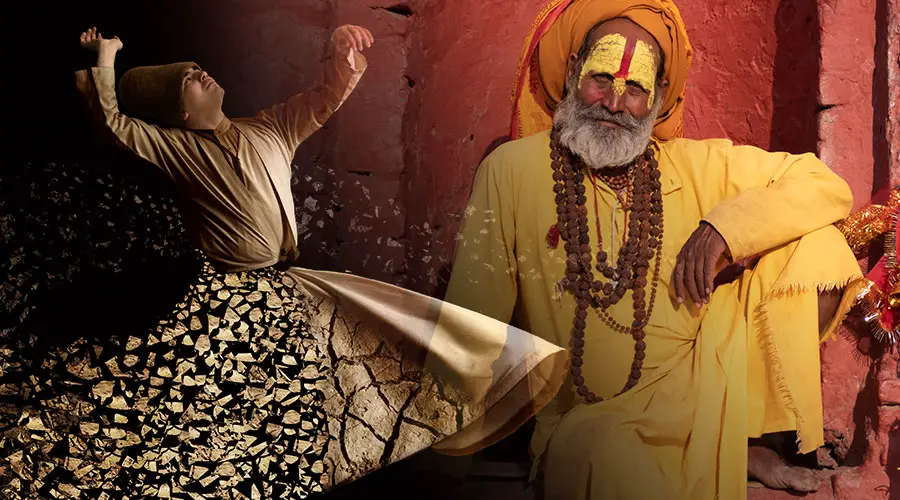Sufism and Hinduism are both religions from the East, rich in meaning and symbolism. They both aim to bring their worshippers to union with God, and they have a lot in common.
Sufism and Hinduism are similar in that they worship the supreme being in temples, have messengers and sacred scriptures, practice dances, have concepts about life and death, and practice the recital of the names Gods. They are tolerant of other religions, and have been embraced by the West.
Although there are a lot of differences as well, the two religions are part of a larger picture, or a universal truth.

Both Worship the Supreme Being
The essence of both religions, is the relationship with the supreme being, and both Sufism and Hinduism worship what they see as being the ultimate origin of all creation.
In Islam, the Arabic word Allah means “The God”. It is the all-knowing, all-powerful, and all-merciful creator of the world. In Islam and Sufism, there are 99 names for Allah, each which describe a different attribute.
In Hinduism, the supreme God is known as The Brahman. Everything that exists is a manifestation of Brahman. Brahman manifests in a pantheon of deities, all of whom are ultimately aspects of the supreme being. Like Islam, Hindus have many names for these deities which describe different aspects of who they are.
In this article I am going to be using the terms Islam and Sufism interchangeably, as Sufism is an aspect of Islam. There are differences between the two, which I will point out when it is relevant. For a thorough explanations of the differences between Islam and Sufism, click here.
The Supreme Being Sends Messengers to Our World
Another similarity is that the Supreme Being at times has sent various people to our world to teach humanity and bring about changes. In Islam, Allah sent the prophets Noah, Abraham, Moses, David, Jesus, and then Muhammad, who is considered the final prophet in Islam.
In Hinduism, it’s a little more complex, but essentially the same. Brahman the supreme manifests in a variety of deities, such as Vishnu, Shiva, and Brahma. At times these deities incarnate in our world as avatars, in order to create certain changes. An avatar is when a deity takes on the form of a human or animal. Throughout history, these deities have appeared many times in the forms of avatars.

Worship in Temples
Members of both faiths express their piety by attending temples, as well as celebrating annual festivals. While Hindus bring coconuts, incense, bananas and flower to mandir (their word for temple), the Sufis bring sweets called Jilabees, incense, coconuts and flowers to graves of saints, which are called Darghas.
Sacred Scriptures of Revealed Teachings
Both faiths have sacred texts in which their teachings are contained. Hinduism has the Vedas, which are scriptures revealed to the Rishis (prophets) over a long period of time. From about the 15th century to the 5th century BC, the Vedas were handed down orally, before being written down in Sanskrit.
Sufism has the Quran which was revealed to the prophet Muhammad. In 610 AD, while in a cave in the mountains of Mecca, the angel Gabriel appeared before him and commanded him to become the Arab prophet of the true religion. This began a lifetime of revelations, and between 610 and 632 AD the Quran was revealed to Muhammed, who had scribes write it down as he recited it.

Both Sufism and Hinduism have Dances
The dancing of Sufism is one of the primary differences between Sufism and Islam. The Sufi dancers are called the Whirling Dervishes, who practice a form of active meditation, with the aim of achieving a state of ecstasy in order to get in touch with God.
Hinduism also practices traditional dances, which are an integral part of the culture of India. These dances were codified in the Natya Shastra, a Sanskrit text that was written sometime between 200 BC and 200 AD. When Shiva destroys the world in order to reset cosmic order, he does so by performing a dance called Tandav, which is the cosmic dance of death. Because of this he is sometimes called the Lord of Dance.
Islam is Linear, Hinduism is Circular
Both Islam and Hinduism have a sense of an overarching movement of time to the human experience. Islam describes the process of creation, existence, destruction, and judgement where the believers go to heaven and the non-believers go to hell for the rest of eternity.
Hinduism on the other hand, is about circular cycles, without beginning or end. Rather than going to the afterlife for eternity, Hindus believe in “samsara”, which is the process of continually reincarnating again and again.
Both Have Ultimate Goals
For Muslims, the goal is to go to heaven and attain eternal pleasure. It is very luxurious with gardens, delicious food and sex with beautiful houris. However, Sufism is different in this regard, and much more like Hinduism. The Sufis, are seeking only to be in the presence of God, rather than to living in a luxurious paradise.
Like the Sufis, the goal of Hinduism is to return to our source and find union with God. It is believed that through the completion of karma, one can escape the life and death cycle, finding eternal bliss.
Both Believe in Reciting the Names of Gods to Create Inner Purification
Along with dancing, Sufis use the recital of the names of Gods in order to obtain their ecstatic state. The practice is called “Dhikr”, and there are different phrases and prayers which are repeatedly chanted. Each Dhikr, along with a different phrase or prayer, has a specific posture, breathing, and movement that goes along with it.
Hinduism is rich in prayers as well as mantras, which are phrases that are repeatedly stated. The most basic mantra is the Om, which is the source of all mantras.

Both Recognize Truth in Other Religions
Unlike many other faiths, Hinduism is totally non-exclusive and accepts all other faiths. In fact, to a Hindu, a Christian could be considered a Hindu, as they are someone worshiping their god. Hindus called Christ an “acharya” and consider his message to be the same as that of Lord Krishnu.
Sufism is similar, taking a much different attitude than Islam. Especially in recent times, as Sufism has been pushed out of Islam by reform movements and fundamentalists, Sufism has found a new role in the world, becoming more aligned with contemporary universalist religious movements.
Both Embraced by the 1960s Cultural Revolution in the West
Another thing Sufism and Hinduism have in common is they were discovered by the West in the 1960s. It was a time of sexual revolution, and intense interest in the mystical and exotic ideas of the East. The Beatles famously visited India to learn meditation at this time. Although Hinduism and Buddhism perhaps got the most attention, Sufism was also seen as an exotic eastern practice, whose more progressive attitudes resonated with the western spiritual seekers of the time.
Recommended Reading
If you want to continue exploring this subject more deeply, you can see which books I recommend by clicking here.
